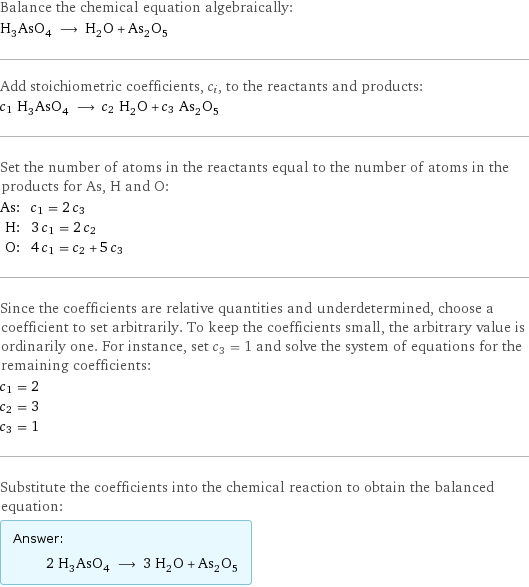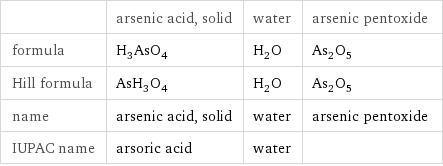Input interpretation

H_3AsO_4 arsenic acid, solid ⟶ H_2O water + As_2O_5 arsenic pentoxide
Balanced equation

Balance the chemical equation algebraically: H_3AsO_4 ⟶ H_2O + As_2O_5 Add stoichiometric coefficients, c_i, to the reactants and products: c_1 H_3AsO_4 ⟶ c_2 H_2O + c_3 As_2O_5 Set the number of atoms in the reactants equal to the number of atoms in the products for As, H and O: As: | c_1 = 2 c_3 H: | 3 c_1 = 2 c_2 O: | 4 c_1 = c_2 + 5 c_3 Since the coefficients are relative quantities and underdetermined, choose a coefficient to set arbitrarily. To keep the coefficients small, the arbitrary value is ordinarily one. For instance, set c_3 = 1 and solve the system of equations for the remaining coefficients: c_1 = 2 c_2 = 3 c_3 = 1 Substitute the coefficients into the chemical reaction to obtain the balanced equation: Answer: | | 2 H_3AsO_4 ⟶ 3 H_2O + As_2O_5
Structures

⟶ +
Names

arsenic acid, solid ⟶ water + arsenic pentoxide
Reaction thermodynamics
Enthalpy

| arsenic acid, solid | water | arsenic pentoxide molecular enthalpy | -906.3 kJ/mol | -285.8 kJ/mol | -924.9 kJ/mol total enthalpy | -1813 kJ/mol | -857.5 kJ/mol | -924.9 kJ/mol | H_initial = -1813 kJ/mol | H_final = -1782 kJ/mol | ΔH_rxn^0 | -1782 kJ/mol - -1813 kJ/mol = 30.21 kJ/mol (endothermic) | |
Equilibrium constant
![Construct the equilibrium constant, K, expression for: H_3AsO_4 ⟶ H_2O + As_2O_5 Plan: • Balance the chemical equation. • Determine the stoichiometric numbers. • Assemble the activity expression for each chemical species. • Use the activity expressions to build the equilibrium constant expression. Write the balanced chemical equation: 2 H_3AsO_4 ⟶ 3 H_2O + As_2O_5 Assign stoichiometric numbers, ν_i, using the stoichiometric coefficients, c_i, from the balanced chemical equation in the following manner: ν_i = -c_i for reactants and ν_i = c_i for products: chemical species | c_i | ν_i H_3AsO_4 | 2 | -2 H_2O | 3 | 3 As_2O_5 | 1 | 1 Assemble the activity expressions accounting for the state of matter and ν_i: chemical species | c_i | ν_i | activity expression H_3AsO_4 | 2 | -2 | ([H3AsO4])^(-2) H_2O | 3 | 3 | ([H2O])^3 As_2O_5 | 1 | 1 | [As2O5] The equilibrium constant symbol in the concentration basis is: K_c Mulitply the activity expressions to arrive at the K_c expression: Answer: | | K_c = ([H3AsO4])^(-2) ([H2O])^3 [As2O5] = (([H2O])^3 [As2O5])/([H3AsO4])^2](../image_source/815d6ab974b52fcab89b1f8f27f79811.png)
Construct the equilibrium constant, K, expression for: H_3AsO_4 ⟶ H_2O + As_2O_5 Plan: • Balance the chemical equation. • Determine the stoichiometric numbers. • Assemble the activity expression for each chemical species. • Use the activity expressions to build the equilibrium constant expression. Write the balanced chemical equation: 2 H_3AsO_4 ⟶ 3 H_2O + As_2O_5 Assign stoichiometric numbers, ν_i, using the stoichiometric coefficients, c_i, from the balanced chemical equation in the following manner: ν_i = -c_i for reactants and ν_i = c_i for products: chemical species | c_i | ν_i H_3AsO_4 | 2 | -2 H_2O | 3 | 3 As_2O_5 | 1 | 1 Assemble the activity expressions accounting for the state of matter and ν_i: chemical species | c_i | ν_i | activity expression H_3AsO_4 | 2 | -2 | ([H3AsO4])^(-2) H_2O | 3 | 3 | ([H2O])^3 As_2O_5 | 1 | 1 | [As2O5] The equilibrium constant symbol in the concentration basis is: K_c Mulitply the activity expressions to arrive at the K_c expression: Answer: | | K_c = ([H3AsO4])^(-2) ([H2O])^3 [As2O5] = (([H2O])^3 [As2O5])/([H3AsO4])^2
Rate of reaction
![Construct the rate of reaction expression for: H_3AsO_4 ⟶ H_2O + As_2O_5 Plan: • Balance the chemical equation. • Determine the stoichiometric numbers. • Assemble the rate term for each chemical species. • Write the rate of reaction expression. Write the balanced chemical equation: 2 H_3AsO_4 ⟶ 3 H_2O + As_2O_5 Assign stoichiometric numbers, ν_i, using the stoichiometric coefficients, c_i, from the balanced chemical equation in the following manner: ν_i = -c_i for reactants and ν_i = c_i for products: chemical species | c_i | ν_i H_3AsO_4 | 2 | -2 H_2O | 3 | 3 As_2O_5 | 1 | 1 The rate term for each chemical species, B_i, is 1/ν_i(Δ[B_i])/(Δt) where [B_i] is the amount concentration and t is time: chemical species | c_i | ν_i | rate term H_3AsO_4 | 2 | -2 | -1/2 (Δ[H3AsO4])/(Δt) H_2O | 3 | 3 | 1/3 (Δ[H2O])/(Δt) As_2O_5 | 1 | 1 | (Δ[As2O5])/(Δt) (for infinitesimal rate of change, replace Δ with d) Set the rate terms equal to each other to arrive at the rate expression: Answer: | | rate = -1/2 (Δ[H3AsO4])/(Δt) = 1/3 (Δ[H2O])/(Δt) = (Δ[As2O5])/(Δt) (assuming constant volume and no accumulation of intermediates or side products)](../image_source/2f8bc62c097e469ae973fa4971b016ef.png)
Construct the rate of reaction expression for: H_3AsO_4 ⟶ H_2O + As_2O_5 Plan: • Balance the chemical equation. • Determine the stoichiometric numbers. • Assemble the rate term for each chemical species. • Write the rate of reaction expression. Write the balanced chemical equation: 2 H_3AsO_4 ⟶ 3 H_2O + As_2O_5 Assign stoichiometric numbers, ν_i, using the stoichiometric coefficients, c_i, from the balanced chemical equation in the following manner: ν_i = -c_i for reactants and ν_i = c_i for products: chemical species | c_i | ν_i H_3AsO_4 | 2 | -2 H_2O | 3 | 3 As_2O_5 | 1 | 1 The rate term for each chemical species, B_i, is 1/ν_i(Δ[B_i])/(Δt) where [B_i] is the amount concentration and t is time: chemical species | c_i | ν_i | rate term H_3AsO_4 | 2 | -2 | -1/2 (Δ[H3AsO4])/(Δt) H_2O | 3 | 3 | 1/3 (Δ[H2O])/(Δt) As_2O_5 | 1 | 1 | (Δ[As2O5])/(Δt) (for infinitesimal rate of change, replace Δ with d) Set the rate terms equal to each other to arrive at the rate expression: Answer: | | rate = -1/2 (Δ[H3AsO4])/(Δt) = 1/3 (Δ[H2O])/(Δt) = (Δ[As2O5])/(Δt) (assuming constant volume and no accumulation of intermediates or side products)
Chemical names and formulas

| arsenic acid, solid | water | arsenic pentoxide formula | H_3AsO_4 | H_2O | As_2O_5 Hill formula | AsH_3O_4 | H_2O | As_2O_5 name | arsenic acid, solid | water | arsenic pentoxide IUPAC name | arsoric acid | water |
Substance properties

| arsenic acid, solid | water | arsenic pentoxide molar mass | 141.94 g/mol | 18.015 g/mol | 229.84 g/mol phase | solid (at STP) | liquid (at STP) | solid (at STP) melting point | 35.5 °C | 0 °C | 300 °C boiling point | 160 °C | 99.9839 °C | density | 2.2 g/cm^3 | 1 g/cm^3 | 4.09 g/cm^3 surface tension | | 0.0728 N/m | dynamic viscosity | | 8.9×10^-4 Pa s (at 25 °C) | odor | | odorless |
Units
